Meteorological Differences Characterizing Tornado Outbreak Forecasts of Varying Quality
Abstract
1. Introduction
2. Data and Methodology
2.1. Data
2.2. Methods
3. Results
3.1. General Outbreak Characteristics
3.2. Synoptic-Scale Composite Results
3.3. Mesoscale Characteristics
4. Discussion
5. Conclusions
Author Contributions
Funding
Acknowledgments
Conflicts of Interest
References
- Hayes, J.L. The Historic Tornadoes of April 2011; U.S. Department of Commerce Service Assessment: Silver Spring, MD, USA, 2011; 76p. Available online: https://www.weather.gov/media/publications/assessments/historic_tornadoes.pdf (accessed on 12 December 2018).
- Blunden, J.; Arndt, D.S. State of the climate in 2011. Bull. Am. Meteorol. Soc. 2011, 93, S1–S282. [Google Scholar] [CrossRef]
- Shafer, C.M.; Doswell, C.A. A multivariate index for ranking and classifying severe weather outbreaks. Electron. J. Severe Storms Meteorol. 2011, 5, 1–39. [Google Scholar]
- Thompson, R.L.; Edwards, R. An overview of environmental conditions and forecast implications of the 3 May 1999 Tornado Outbreak. Weather Forecast. 2000, 15, 682–699. [Google Scholar] [CrossRef]
- Galway, J.G. Some climatological aspects of tornado outbreaks. Mon. Weather Rev. 1977, 105, 477–484. [Google Scholar] [CrossRef]
- Grazulis, T.P. Significant Tornadoes 1680–1991; Environmental Films: St. Johnsbury, VT, USA, 1993; 1326p, ISBN 978-1879362031. [Google Scholar]
- Fuhrmann, C.M.; Konrad, C., II; Kovach, M. Ranking of tornado outbreaks across the United States and their climatological characteristics. Weather Forecast. 2014, 29, 684–701. [Google Scholar] [CrossRef]
- Doswell, C.A.; Edwards, R.; Thompson, R.L.; Hart, J.A.; Crosbie, K.C. A simple and flexible method for ranking severe weather events. Weather Forecast. 2006, 21, 939–951. [Google Scholar] [CrossRef]
- Herman, G.R.; Nielsen, E.R.; Schumacher, R.S. Probabilistic verification of Storm Prediction Center convective outlooks. Weather Forecast. 2018, 33, 161–184. [Google Scholar] [CrossRef]
- Edwards, R.; Corfidi, S.F.; Thompson, R.L.; Evans, J.S.; Craven, J.P.; Racy, J.P.; McCarthy, D.W.; Vescio, M.D. Storm Prediction Center forecasting issues related to the 3 May 1999 Tornado Outbreak. Weather Forecast. 2002, 17, 544–558. [Google Scholar] [CrossRef]
- Evans, J.S.; Mead, C.M.; Weiss, S.J. Forecasting the Super Tuesday tornado outbreak at the Storm Prediction Center: Why forecast uncertainty does not necessarily decrease as you get closer to a high impact weather event. In Proceedings of the 24th Conference Severe Local Storms, Savannah, GA, USA, 27–31 October 2008. [Google Scholar]
- Shafer, C.M.; Mercer, A.E.; Richman, M.B.; Leslie, L.M.; Doswell, C.A. An assessment of areal coverage of severe weather parameters for severe weather outbreak diagnosis. Weather Forecast. 2012, 27, 809–831. [Google Scholar] [CrossRef]
- Mercer, A.E.; Shafer, C.M.; Doswell, C.A.; Leslie, L.M.; Richman, M.B. Synoptic composites of tornadic and nontornadic outbreaks. Mon. Weather Rev. 2012, 140, 2590–2608. [Google Scholar] [CrossRef]
- Beebe, R.G. Tornado composite charts. Mon. Weather Rev. 1956, 84, 127–142. [Google Scholar] [CrossRef]
- Lowe, A.B.; McKay, G.A. Tornado composite charts for the Canadian Prairies. J. Appl. Meteorol. 1962, 1, 157–162. [Google Scholar] [CrossRef]
- Hagemeyer, B. Peninsular Florida tornado outbreaks. Weather Forecast. 1997, 12, 399–427. [Google Scholar] [CrossRef]
- Gaffin, D.M.; Parker, S.S. A climatology of synoptic conditions associated with significant tornadoes over the southern Appalachian region. Weather Forecast. 2006, 21, 735–751. [Google Scholar] [CrossRef]
- Banacos, P.C.; Ekster, M.L. The association of the elevated mixed layer with significant severe weather events in the northeastern United States. Weather Forecast. 2010, 25, 1082–1102. [Google Scholar] [CrossRef]
- Wasula, A.C.; Bosart, L.F.; Schneider, R.; Weiss, S.J.; Johns, R.H.; Manikin, G.S.; Welsh, P. Mesoscale aspects of the rapid intensification of a tornadic convective line across central Florida: 22–23 February 1998. Weather Forecast. 2007, 22, 223–243. [Google Scholar] [CrossRef]
- Schaefer, J.T.; Doswell, C.A. Empirical orthogonal function expansion applied to progressive tornado outbreaks. J. Meteorol. Soc. Japan 1984, 62, 929–936. [Google Scholar] [CrossRef]
- Mercer, A.E.; Richman, M.B.; Leslie, L.M. Identification of severe weather outbreaks using kernel principal component analysis. Procedia Comp. Sci. 2011, 6, 231–236. [Google Scholar] [CrossRef]
- Skamarock, W.C.; Klemp, J.B.; Dudhia, J.; Gill, D.O.; Barker, D.M.; Duda, M.G.; Huang, X.; Wang, W.; Powers, J.G. A Description of the Advanced Research WRF Version 3; NCAR Technik Note; NCAR/TN-475+STR: Boulder, CO, USA, 2008; 125p. [Google Scholar]
- SPC Severe Weather Report Archive. Available online: https://www.spc.noaa.gov/archive (accessed on 20 November 2018).
- Mesinger, F.; DiMego, G.; Kalnay, E.; Mitchell, K.; Shafran, P.C.; Ebisuzaki, W.; Jović, D.; Woollen, J.; Rogers, E.; Berbery, E.H.; et al. North American Regional Reanalysis. Bull. Am. Meteorol. Soc. 2006, 87, 343–360. [Google Scholar] [CrossRef]
- Shafer, C.M.; Doswell, C.A. Using kernel density estimation to identify, rank, and classify severe weather outbreak events. E J. Severe Storms. Meteorol. 2011, 6, 1–28. [Google Scholar]
- Wilks, D.S. Statistical Methods in the Atmospheric Sciences; Academic Press: Ithaca, NY, USA, 2011; 704p. [Google Scholar]
- Rousseeuw, P. Silhouettes, a graphical aid for the interpretation and validation of cluster analysis. J. Comp. Appl. Math. 1987, 20, 53–65. [Google Scholar] [CrossRef]
- Grell, G.; Devenyi, D. A generalized approach to parameterizing convection combining ensemble and data assimilation techniques. Geophys. Res. Lett. 2002, 29, 1693. [Google Scholar] [CrossRef]
- Hong, S.; Pan, H. Nonlocal boundary layer vertical diffusion in a medium-range forecast model. Mon. Weather Rev. 1996, 124, 2322–2339. [Google Scholar] [CrossRef]
- Mlawer, E.; Taubman, S.; Brown, P.; Iacono, M.; Clough, S. Radiative transfer for inhomogeneous atmospheres: RRTM, a validated correlated-k model for the longwave. J. Geophys. Res. 1997, 102, 663–682. [Google Scholar] [CrossRef]
- Dudhia, J. Numerical study of convection observed during the Winter Monsoon Experiment using a mesoscale two-dimensional model. J. Atmos. Sci. 1989, 46, 3077–3107. [Google Scholar] [CrossRef]
- Fairall, C.; Bradley, E.; Hare, J.; Grachev, A.; Edson, J. Bulk parameterization of air-sea fluxes: Updates and verification for the COARE algorithm. J. Clim. 2003, 16, 571–591. [Google Scholar] [CrossRef]
- Smith, B.T.; Thompson, R.L.; Grams, J.S.; Broyles, C.; Brooks, H.E. Convective modes for significant severe thunderstorms in the contiguous United States. Part I: Storm classification and climatology. Weather Forecast. 2012, 27, 1114–1135. [Google Scholar] [CrossRef]
- Baggett, C.F.; Nardi, K.M.; Childs, S.J.; Zito, S.N.; Barnes, E.A.; Maloney, E.D. Skillful subseasonal forecasts of weekly tornado and hail activity using the Madden-Julian Oscillation. J. Geophys. Res. Atmos. 2018, 123, 661–675. [Google Scholar] [CrossRef]
- Brooks, H.E. Climatological estimates of local daily tornado probability for the United States. Weather Forecast. 2003, 18, 626–640. [Google Scholar] [CrossRef]
- Lackmann, G. Midlatitude Synoptic Meteorology: Dynamics, Analysis, and Forecasting; American Meteorological Society: Boston, MA, USA, 2011; 345p. [Google Scholar]
- Thompson, R.L.; Edwards, R.; Hart, J.A. Evaluation and interpretation of the supercell composite and significant tornado parameters at the Storm Prediction Center. In Proceedings of the 21st Conference Severe Local Storms, San Antonio, TX, USA, 11–16 August 2002. [Google Scholar]
- Thompson, R.L.; Edwards, R.; Hart, J.A.; Elmore, K.L.; Markowski, P. Close proximity soundings within supercell environments obtained from the rapid update cycle. Weather Forecast. 2003, 18, 1243–1261. [Google Scholar] [CrossRef]
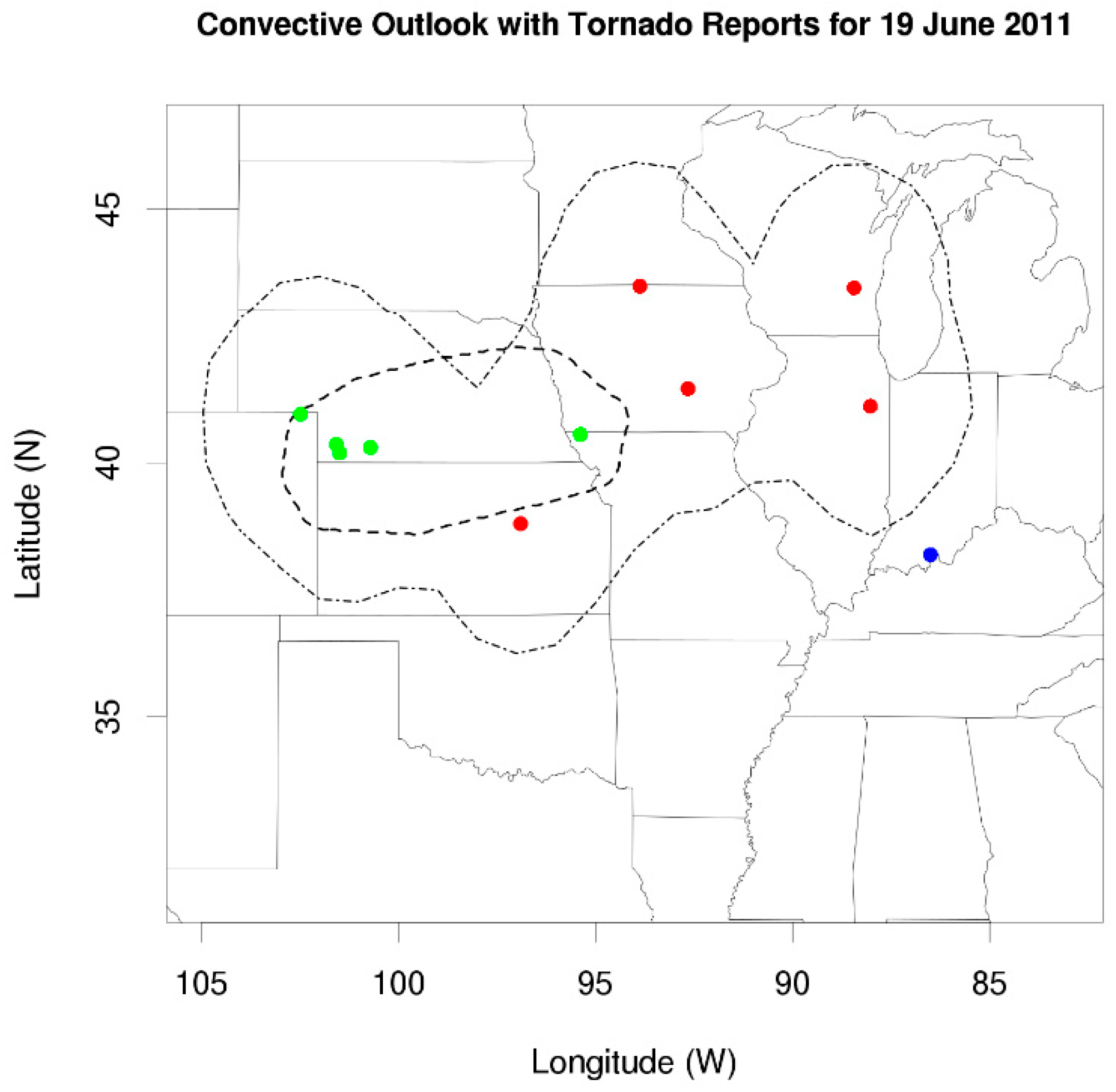
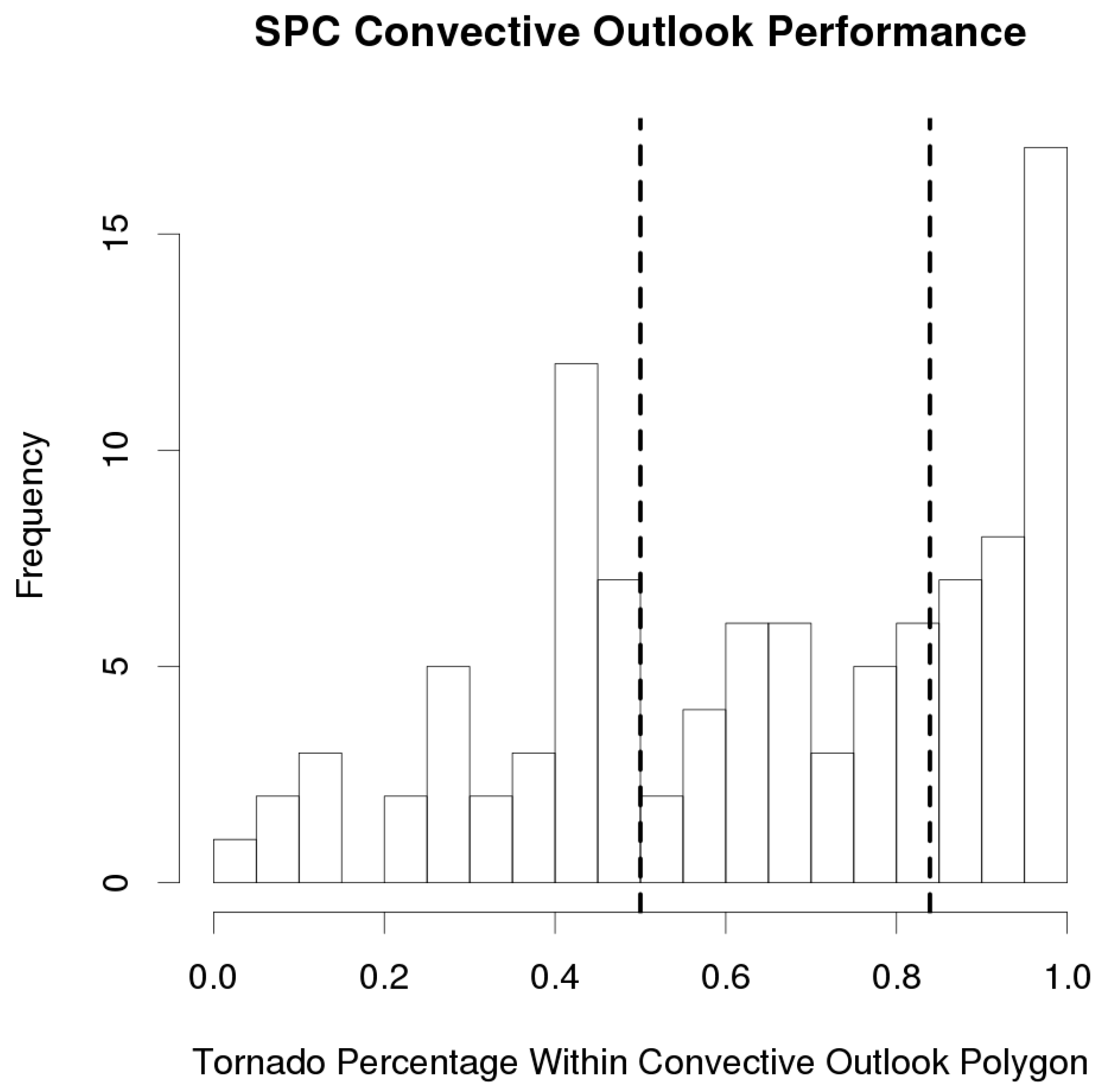


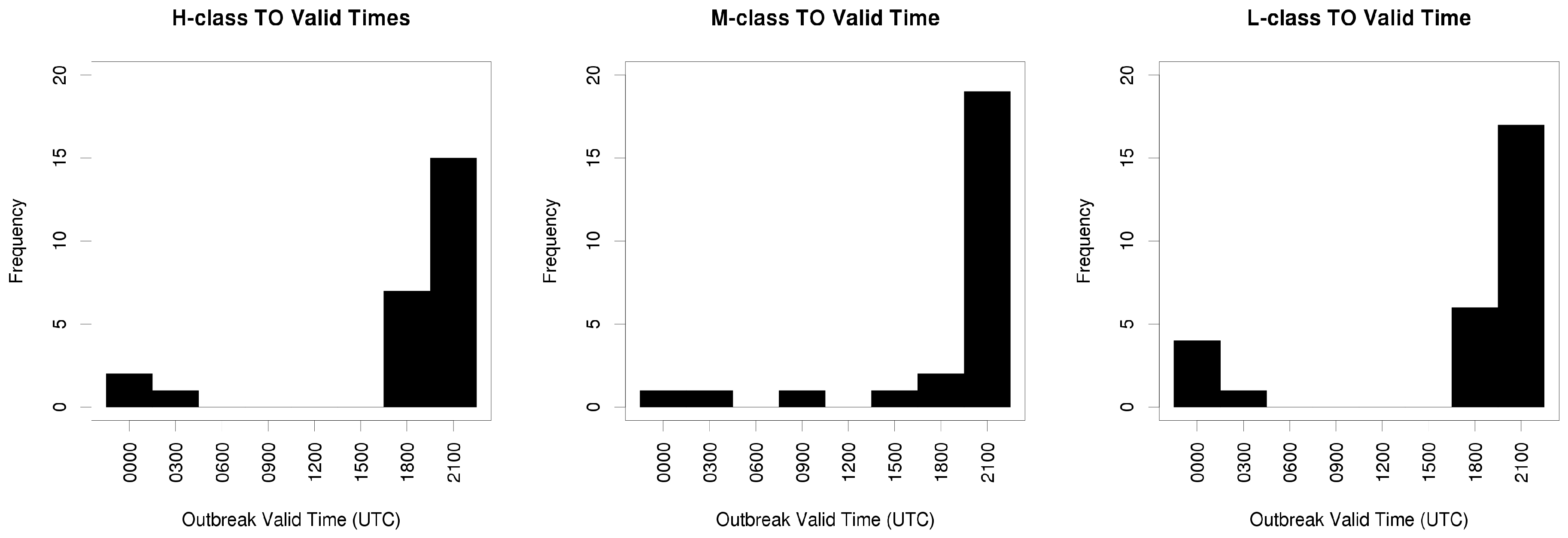

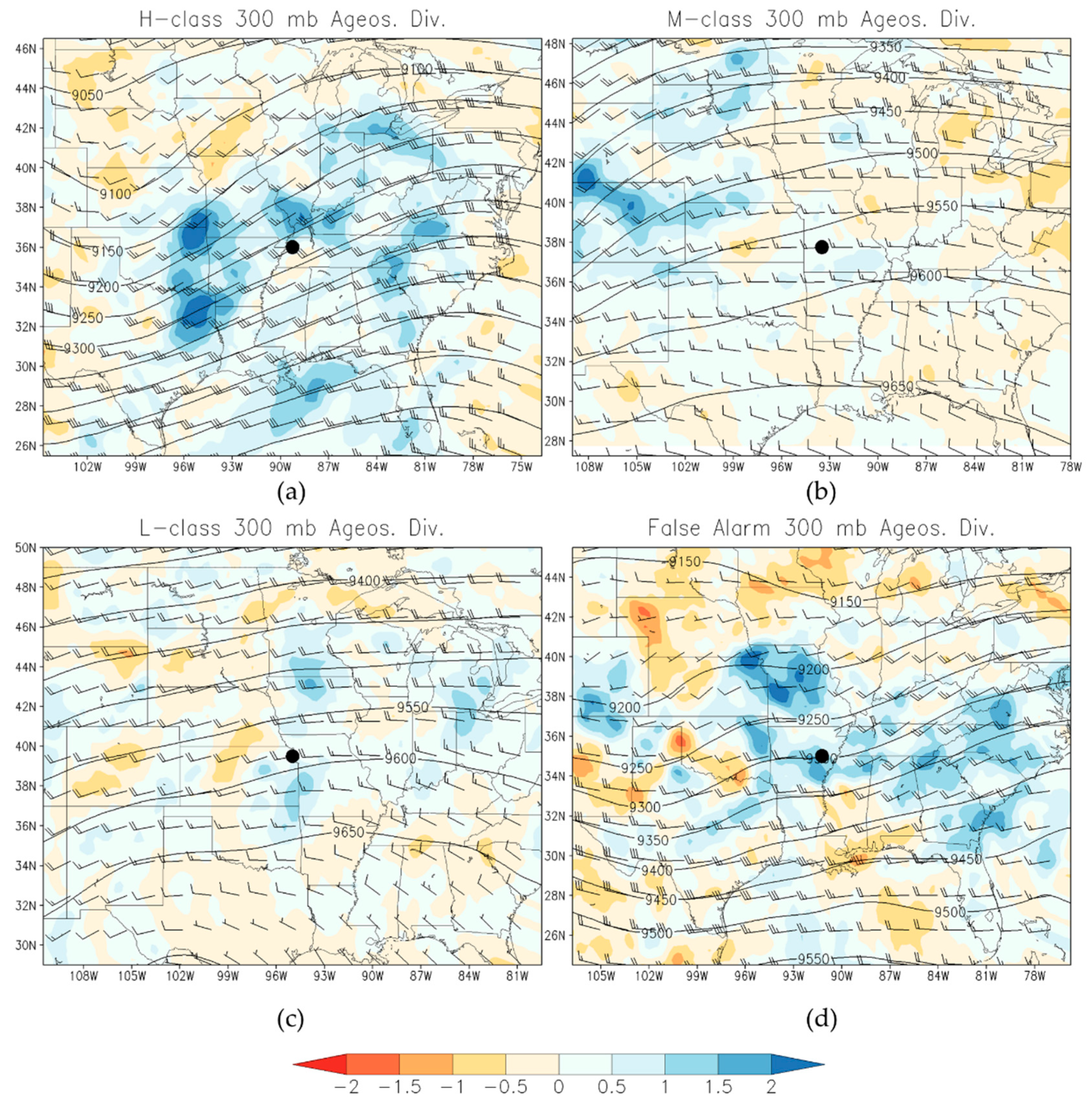

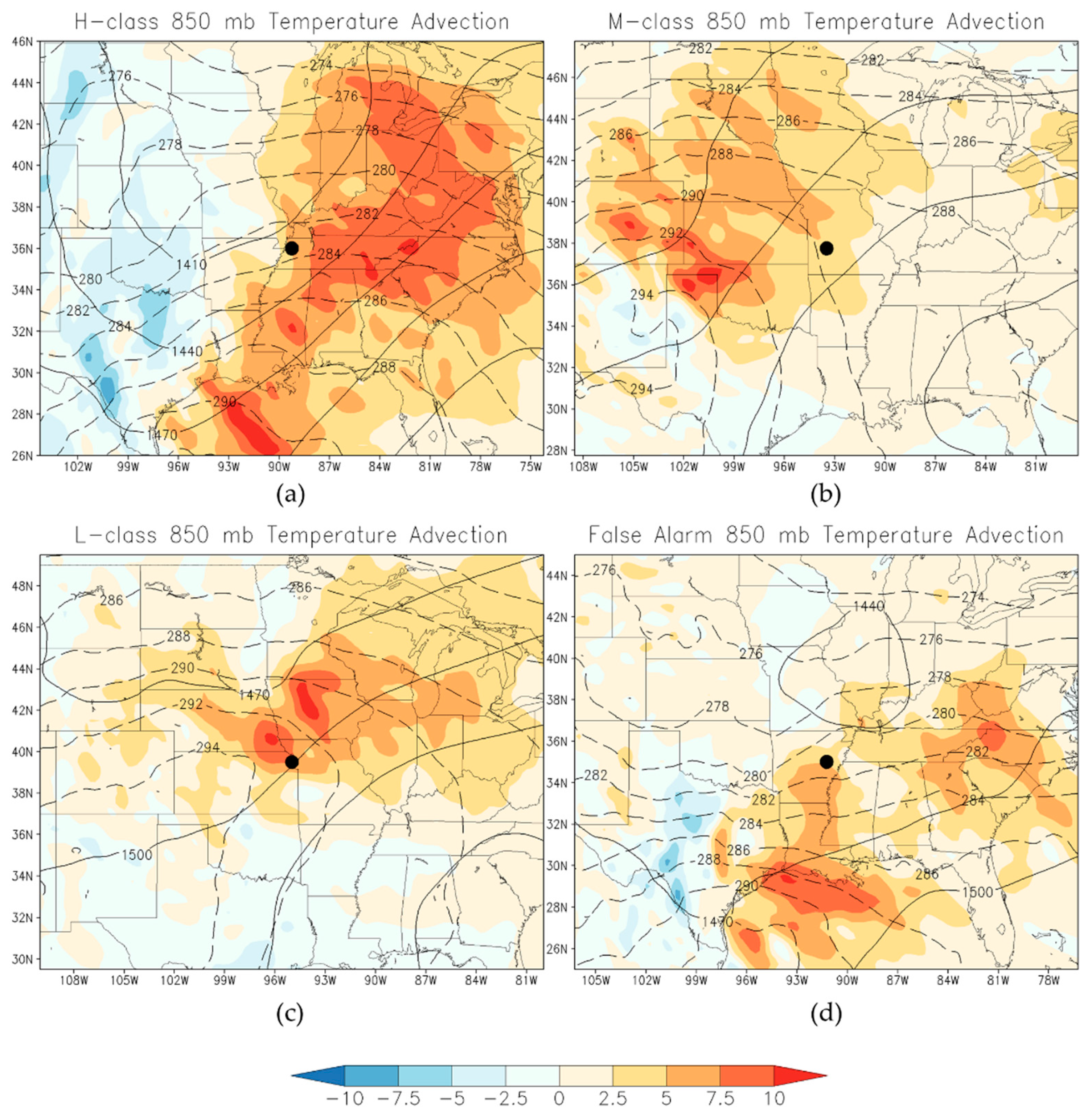
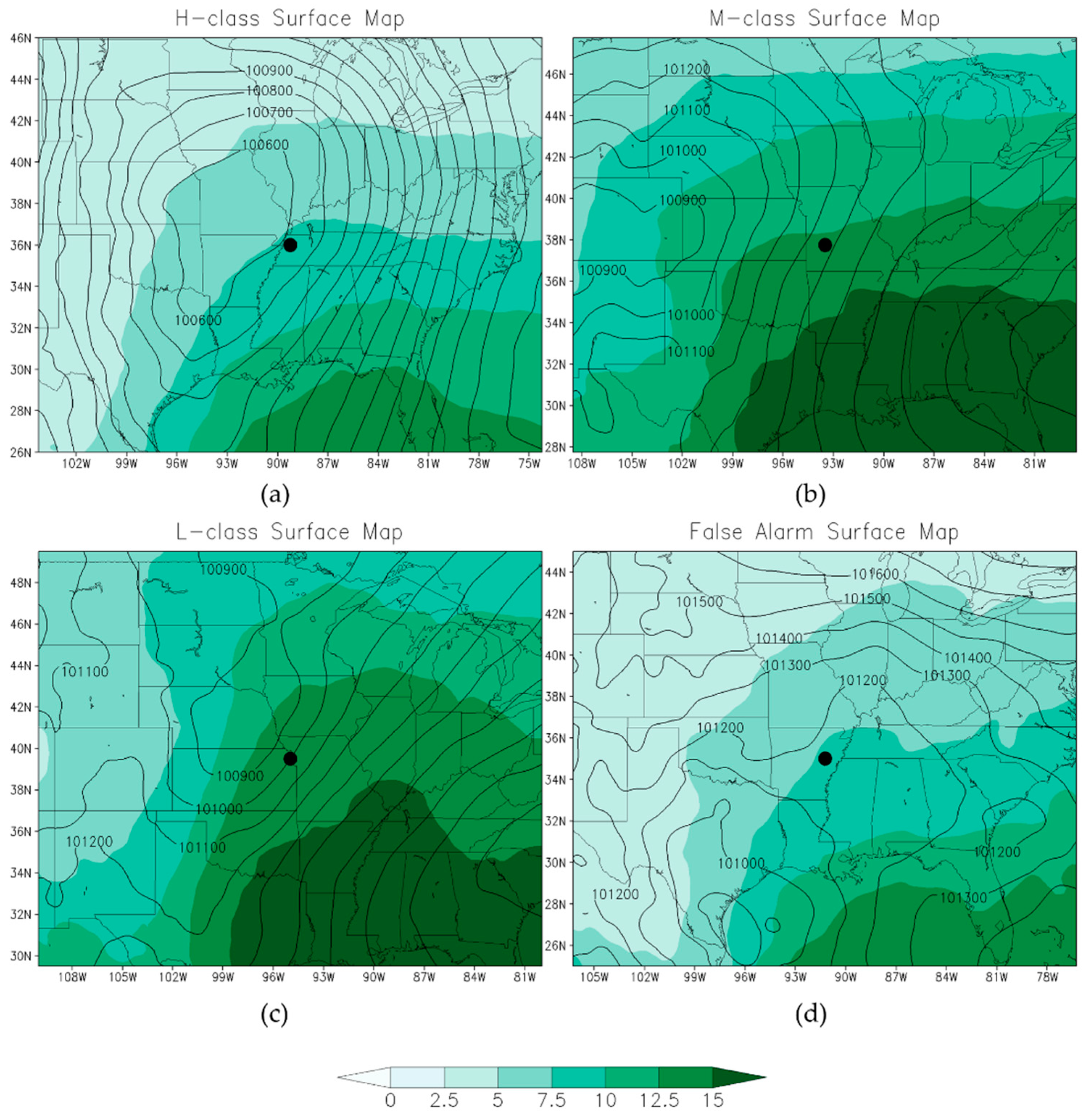
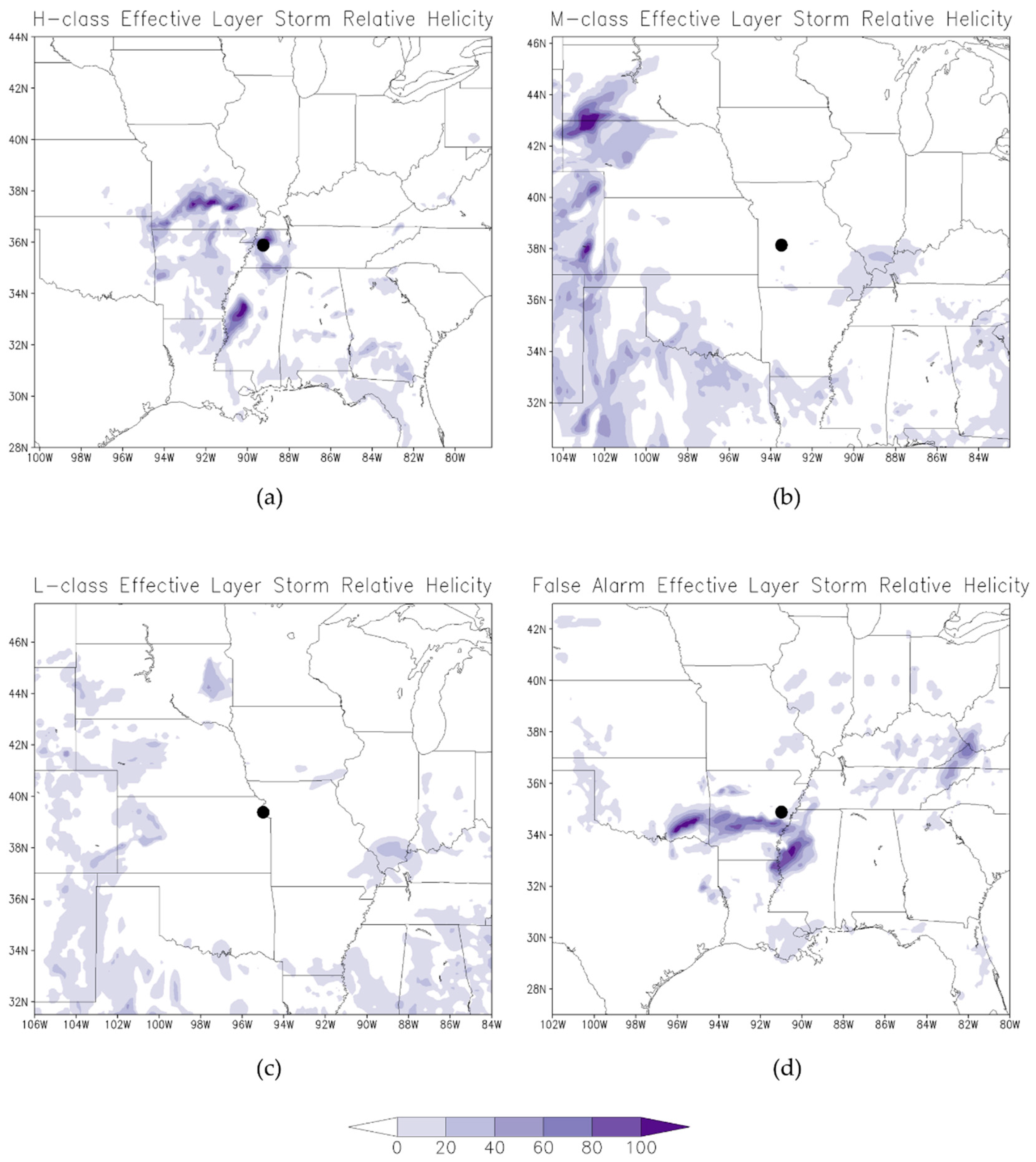
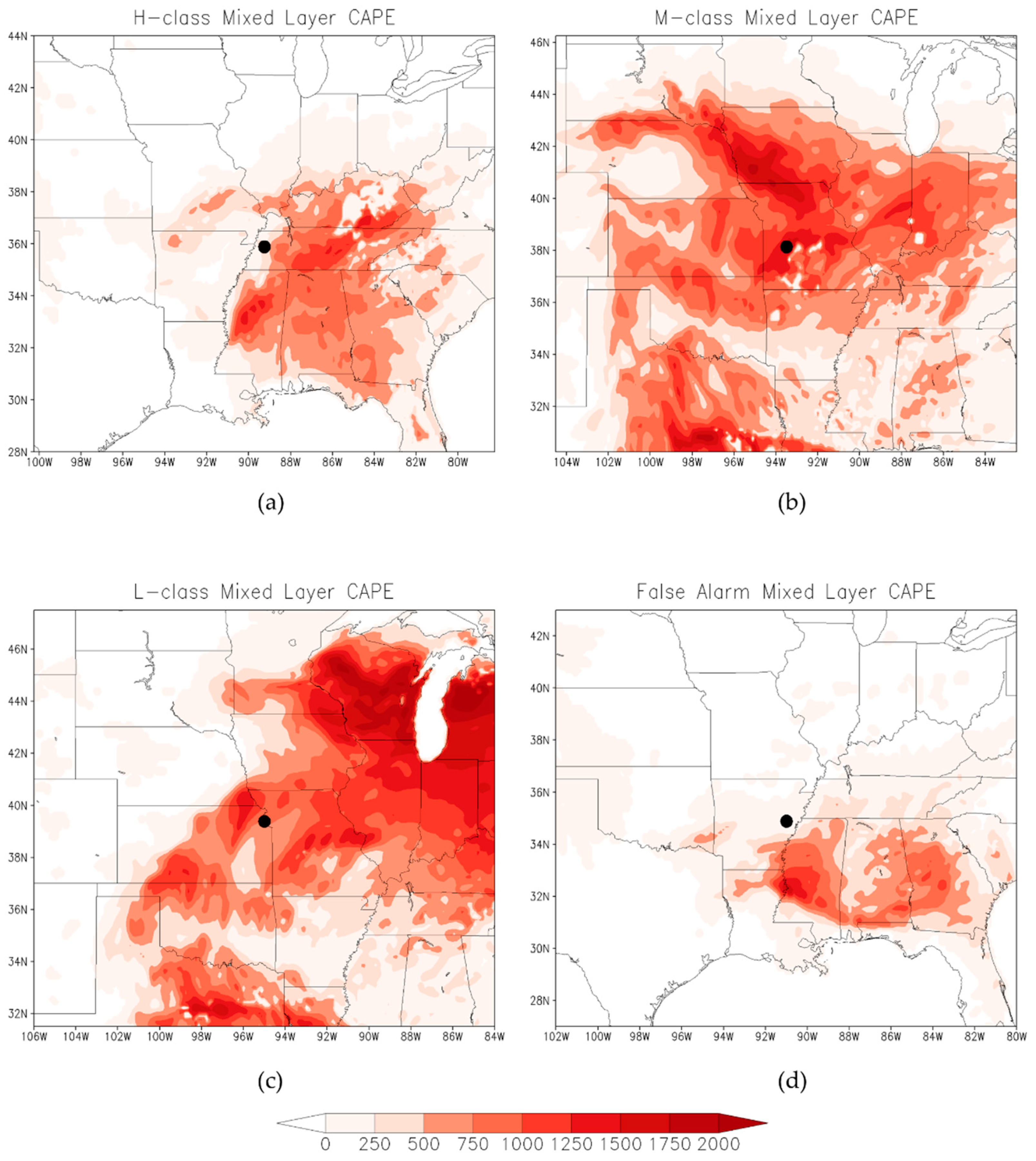
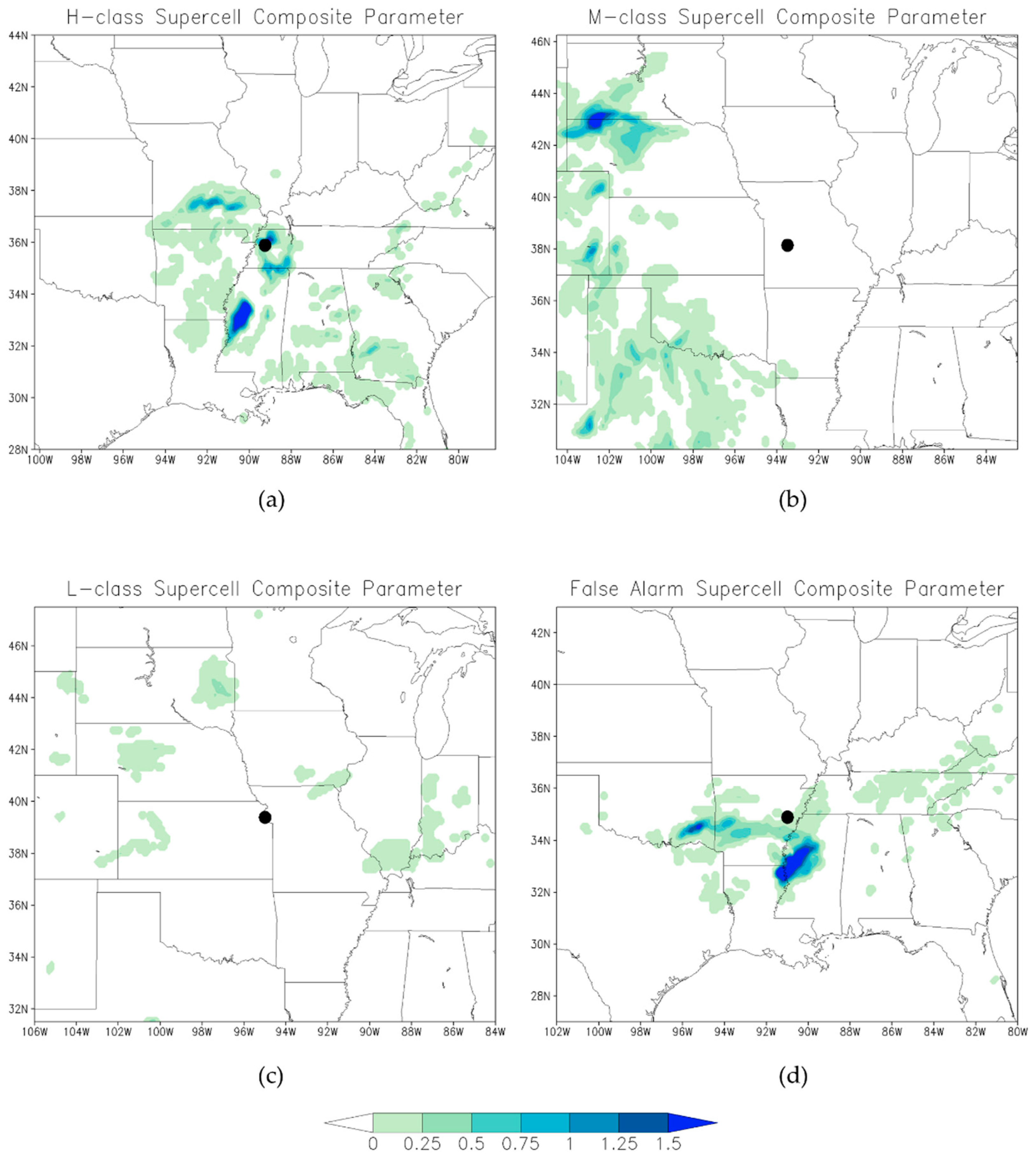
| Forecast Class | Clustering Method | Misclustered | Clusters Kept | Cluster Sizes | |
|---|---|---|---|---|---|
| H-class | K-means | 0.181 | 0 | 3 | 9, 4, 21 |
| M-class | Ward’s Hierarchical | 0.220 | 1 | 2 | 8, 22 |
| L-class | Ward’s Hierarchical | 0.220 | 2 | 2 | 10, 26 |
| False Alarms | K-means | 0.183 | 1 | 2 | 10, 11 |
| Cluster Name | 500-mb Geopotential Height | |||
|---|---|---|---|---|
| N | 2.5th Percentile | 50th Percentile | 97.5th Percentile | |
| H-Class Cluster 1 | 9 | 0.878 | 0.895 | 0.910 |
| H-Class Cluster 2 | 4 | 0.915 | 0.926 | 0.935 |
| H-Class Cluster 3 | 21 | 0.906 | 0.914 | 0.920 |
| M-Class Cluster 1 | 8 | 0.920 | 0.932 | 0.942 |
| M-Class Cluster 2 | 22 | 0.852 | 0.865 | 0.877 |
| L-Class Cluster 1 | 11 | 0.898 | 0.907 | 0.916 |
| L-Class Cluster 2 | 26 | 0.847 | 0.862 | 0.877 |
| False Alarm Cluster 1 | 10 | 0.850 | 0.869 | 0.887 |
| False Alarm Cluster 2 | 11 | 0.800 | 0.817 | 0.834 |
| Cluster Name | 850-mb Temperature | |||
|---|---|---|---|---|
| N | 2.5th Percentile | 50th Percentile | 97.5th Percentile | |
| H-Class Cluster 1 | 9 | 0.800 | 0.827 | 0.849 |
| H-Class Cluster 2 | 4 | 0.896 | 0.907 | 0.917 |
| H-Class Cluster 3 | 21 | 0.857 | 0.868 | 0.878 |
| M-Class Cluster 1 | 8 | 0.847 | 0.871 | 0.891 |
| M-Class Cluster 2 | 22 | 0.784 | 0.800 | 0.816 |
| L-Class Cluster 1 | 11 | 0.821 | 0.844 | 0.865 |
| L-Class Cluster 2 | 26 | 0.766 | 0.782 | 0.796 |
| False Alarm Cluster 1 | 10 | 0.750 | 0.772 | 0.795 |
| False Alarm Cluster 2 | 11 | 0.789 | 0.819 | 0.845 |
| Cluster Name | 2-m Specific Humidity | |||
|---|---|---|---|---|
| N | 2.5th Percentile | 50th Percentile | 97.5th Percentile | |
| H-Class Cluster 1 | 9 | 0.828 | 0.839 | 0.850 |
| H-Class Cluster 2 | 4 | 0.852 | 0.869 | 0.885 |
| H-Class Cluster 3 | 21 | 0.853 | 0.861 | 0.871 |
| M-Class Cluster 1 | 8 | 0.886 | 0.896 | 0.905 |
| M-Class Cluster 2 | 22 | 0.792 | 0.801 | 0.809 |
| L-Class Cluster 1 | 11 | 0.841 | 0.853 | 0.865 |
| L-Class Cluster 2 | 26 | 0.791 | 0.806 | 0.820 |
| False Alarm Cluster 1 | 10 | 0.778 | 0.794 | 0.808 |
| False Alarm Cluster 2 | 11 | 0.826 | 0.841 | 0.856 |
© 2019 by the authors. Licensee MDPI, Basel, Switzerland. This article is an open access article distributed under the terms and conditions of the Creative Commons Attribution (CC BY) license (http://creativecommons.org/licenses/by/4.0/).
Share and Cite
Mercer, A.; Bates, A. Meteorological Differences Characterizing Tornado Outbreak Forecasts of Varying Quality. Atmosphere 2019, 10, 16. https://doi.org/10.3390/atmos10010016
Mercer A, Bates A. Meteorological Differences Characterizing Tornado Outbreak Forecasts of Varying Quality. Atmosphere. 2019; 10(1):16. https://doi.org/10.3390/atmos10010016
Chicago/Turabian StyleMercer, Andrew, and Alyssa Bates. 2019. "Meteorological Differences Characterizing Tornado Outbreak Forecasts of Varying Quality" Atmosphere 10, no. 1: 16. https://doi.org/10.3390/atmos10010016
APA StyleMercer, A., & Bates, A. (2019). Meteorological Differences Characterizing Tornado Outbreak Forecasts of Varying Quality. Atmosphere, 10(1), 16. https://doi.org/10.3390/atmos10010016




